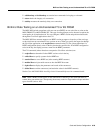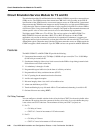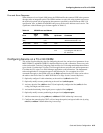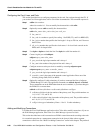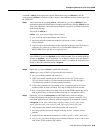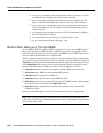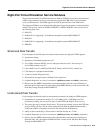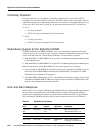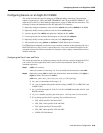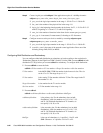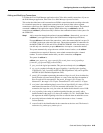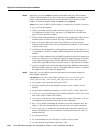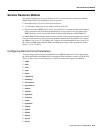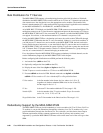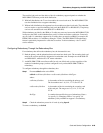
Eight-Port Circuit Emulation Service Modules
Cisco MGX 8850 Installation and Configuration, Release 1.1.00, Part Number 78-6186-02
6-42
Cell Delay Treatment
For each connection, you can configure a tolerable variation in the cell arrival time (CDVT)
according to the expected reliability of the route. The CDVT applies to the receive buffer. After an
underrun, the receiver places the contents of the first cell to arrive in a receive buffer then plays it out
at least one CDVT value later. For each VC, the maximum cell delay and CDVT (or jitter) are:
• For T1
— Cell delay of 48 msec
— CDVT of 24 msec in increments of 125 microseconds
• For E1
— Cell delay of 64 msec
— CDVT of 32 msec in increments of 125 microseconds
Redundancy Support for the Eight-Port CESM
The MGX-CESM-8T1 and MGX-CESM-8E1 can have 1:N redundancy support but with some
variations between the T1 and E1 modes of operation. The type of redundancy and the type of back
card are interdependent. See “Service Resource Module” for more details. In general:
• With an RJ48-8T1, an MGX-SRM-3T3 can provide 1:N redundancy through the distribution bus
or the redundancy bus.
• With an RJ48-8E1, an MGX-SRM-3T3 can provide 1:N redundancy through the redundancy bus.
Back card requirements for the MGX-SRM-3T3 and service modules vary, as follows:
• If you are using the MGX-SRM-3T3 for bulk distribution of T1 channels, the CESMs do not use
back cards, but each MGX-SRM-3T3/B must have an MGX-BNC-3T3-M back card. (Bulk
distribution is not available for E1 operation.)
• If the MGX-SRM-3T3/B supports T1 or E1 1:N redundancy through the redundancy bus (no bulk
distribution), the MGX-SRM-3T3/B does not require a back card, but the N CESM primary cards
must have one redundant version of the back card.
Error and Alarm Response
When it detects a loss of signal (LOS) alarm, the CESM notifies the connected CPE in the upstream
direction after an integration period. The CESM continues to emit cells but sets the ATM cell
payload with an appropriate data pattern as specified by the ATM Forum CES V2.0 specification.
Also, an OAM cell with RDI code goes to the far end to indicate out-of-service. See Table 6-4.
Table 6-4 CESM Errors and Alarms
Error
Alarm
Type
Down
stream Up Stream Comments
Link Failure
(RX)
Blue (LOS) AIS—OAM
cells
none Data cells According to
ATM-Forum CES-IS V 2.0
Receive RAI Yellow None None
Receive LOF n/a n/a .
Receive AIS Blue (AIS) AIS (link) FERF OAM
cells
AIS over the T1 link or
alternating 1s and 0s E1 link.




